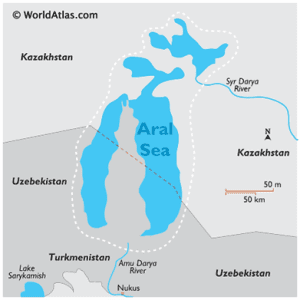TAG: GS 3: ECOLOGY AND ENVIRONMENT
THE CONTEXT: The Aral Sea, once the fourth-largest lake globally, underwent a catastrophic decline in the 1960s due to Soviet irrigation projects, resulting in the emergence of the Aralkum Desert.
EXPLANATION:
- This ecological disaster has far-reaching consequences, impacting both local residents and global climate patterns.
Dust Emissions and Hazards
- The desiccation of the Aral Sea has led to a significant increase in dust emissions, with the desert becoming a substantial source of hazardous particulate matter.
- Dust emissions have nearly doubled over the past 30 years, posing health risks to residents in the region and affecting air quality in nearby capitals such as Tajikistan and Turkmenistan.
Implications for Global Climate
- The dust from the Aralkum Desert not only affects local environments but also has implications for global climate dynamics.
- Dust particles containing residues of fertilizers and pesticides exacerbate the melting of glaciers, contributing to the region’s water crisis.
- Moreover, the dust alters atmospheric conditions, influencing radiative heating and cooling processes.
Research Findings and Methodology
- Researchers from the Leibniz Institute for Tropospheric Research (TROPOS) and Freie Universität Berlin utilized the COSMO-MUSCAT atmospheric dust model to study the effects of Aralkum dust.
- Their findings indicate that dust events occur episodically throughout the year, with notable impacts on surface temperatures and atmospheric pressure.
Radiative Effects and Weather Patterns
- The radiative effects of dust vary depending on factors such as time of day, season, and mineralogical properties.
- While dust can cool the surface during the day by dimming sunlight, it contributes to warming at night by re-emitting heat radiation.
- Changes in atmospheric pressure caused by dust influence weather patterns, intensifying the Siberian High in winter and weakening the Central Asian warm low in summer.
Broader Environmental Concerns
- The Aral Sea’s desiccation mirrors similar environmental crises in West and Central Asia, such as the shrinking of Lake Urmia in Iran and Lake Hamoun on the Iran-Afghanistan border.
- These ‘dust bowls’ not only affect local climates but also have global ramifications, underscoring the urgent need for comprehensive research and mitigation strategies.
Aral Sea:
- It stands at the boundary between Kazakhstan to the north and Uzbekistan to the south.
- It was once a large saltwater lake of Central Asia and the world’s fourth largest body of inland water.
- The remnants of it nestle in the climatically inhospitable heart of Central Asia, to the east of the Caspian Sea.
- The Aral Sea depression was formed toward the end of the Neogene Period (which lasted from about 23 to 2.6 million years ago).
- It was made by waters from the Syr Darya and the Amu Darya rivers that were dependent on glacial melt.
- It drains Uzbekistan and portions of Kazakhstan, Tajikistan, Afghanistan, Turkmenistan, Iran, and Kyrgyzstan.
- Climate: The Aral Sea is located within the harsh climate region of Central Asia. The area experiences a desert-continental climate, characterized by hot summers, cold winters, and varying diurnal air temperature.


